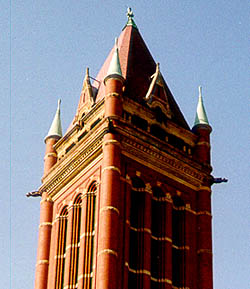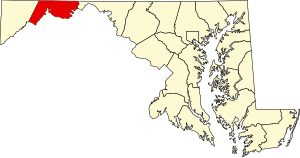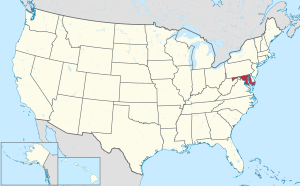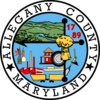
Back مقاطعة ألغني (ماريلاند) Arabic Allegany County, Maryland BAR Алегени (окръг, Мериленд) Bulgarian আলেগান্য কাউন্টি, মেরিল্যান্ড BPY Allegany Gông (Maryland) CDO Аллегейни (гуо, Мэриленд) CE Allegany County (kondado sa Tinipong Bansa, Maryland) CEB Allegany County (Maryland) Czech Allegany County, Maryland Welsh Allegany County (Maryland) Danish
Allegany County | |
|---|---|
 Allegany County Courthouse | |
|
| |
 Location within the U.S. state of Maryland | |
 Maryland's location within the U.S. | |
| Coordinates: 39°38′N 78°41′W / 39.63°N 78.69°W | |
| Country | |
| State | |
| Founded | December 25, 1789 |
| Named for | Allegheny Mountains |
| Seat | Cumberland |
| Largest city | Cumberland |
| Area | |
| • Total | 430 sq mi (1,100 km2) |
| • Land | 424 sq mi (1,100 km2) |
| • Water | 5.8 sq mi (15 km2) 1.3% |
| Population (2020) | |
| • Total | 68,106 |
| • Density | 160/sq mi (61/km2) |
| Time zone | UTC−5 (Eastern) |
| • Summer (DST) | UTC−4 (EDT) |
| Congressional district | 6th |
| Website | www |
Allegany County is a county located in the northwestern part of the U.S. state of Maryland. As of the 2020 census, the population was 68,106.[1] Its county seat is Cumberland.[2] The name Allegany may come from a local Lenape word, welhik hane[3][4] or oolikhanna, which means 'best flowing river of the hills' or 'beautiful stream'.[5] A number of counties and a river in the Appalachian region of the U.S. are named Allegany, Allegheny, or Alleghany. Allegany County is part of the Cumberland metropolitan area. It is a part of the Western Maryland "panhandle".
- ^ "State & County QuickFacts". United States Census Bureau. Retrieved August 16, 2021.
- ^ "Find a County". National Association of Counties. Archived from the original on May 31, 2011. Retrieved June 7, 2011.
- ^ "welhik". Lenape Talking Dictionary. Archived from the original on September 11, 2012. Retrieved December 14, 2011.
- ^ "Heckewelder here does not give the strict meaning of hanne. The word in common use among Algonkin [i.e., Algonquian] tribes for river is sipu, and this includes the idea of 'a stream of flowing water'. But in the mountainous parts of Pennsylvania, Maryland, and Virginia sipu did not sufficiently convey the idea of a rapid stream, roaring down mountain gorges, and hanne takes its place to designate not a mere sipu, or flowing river, but a rapid mountain stream." Russell, Erret (1885). "Indian Geographical Names". The Magazine of Western History. 2 (1): 53–59. Retrieved December 14, 2011.
- ^ Alleghany, or as some prefer to write it, Allegheny,—the Algonkin name of the Ohio River, but now restricted to one of its branches,—is probably (Delaware) welhik-hanné or [oo]lik-hanné, 'the best (or, the fairest) river.' Welhik (as Zeisberger wrote it) is the inanimate form of the adjectival, meaning 'best,' 'most beautiful.' In his Vocabulary, Zeisberger gave this synthesis, with slight change of orthography, as "Wulach'neü" [or [oo]lakhanne[oo], as Eliot would have written it,] with the free translation, "a fine River, without Falls." The name was indeed more likely to belong to rivers 'without falls' or other obstruction to the passage of canoes, but its literal meaning is, as its composition shows, "best rapid-stream," or "finest rapid-stream;" "La Belle Riviere" of the French, and the Oue-yo´ or O hee´ yo Gä-hun´-dä, "good river" or "the beautiful river," of the Senecas. For this translation of the name we have very respectable authority,—that of Christian Frederick Post, a Moravian of Pennsylvania, who lived seventeen years with the Muhhekan Indians and was twice married among them, and whose knowledge of the Indian languages enabled him to render important services to the colony, as a negotiator with the Delawares and Shawanese of the Ohio, in the French war. In his "Journal from Philadelphia to the Ohio" in 1758, after mention of the 'Alleghenny' river, he says: "The Ohio, as it is called by the Sennecas. Alleghenny is the name of the same river in the Delaware language. Both words signify the fine or fair river." La Metairie, the notary of La Salle's expedition, "calls the Ohio, the Olighinsipou, or Aleghin; evidently an Algonkin name,"—as Dr. Shea remarks. Heckewelder says that the Delawares "still call the Allegany (Ohio) river, Alligéwi Sipu,"—"the river of the Alligewi" as he chooses to translate it. In one form, we have wulik-hannésipu, 'best rapid-stream long-river;' in the other, wuliké-sipu, 'best long-river.' Heckewelder's derivation of the name, on the authority of a Delaware legend, from the mythic 'Alligewi' or 'Talligewi,'—"a race of Indians said to have once inhabited that country," who, after great battles fought in pre-historic times, were driven from it by the all-conquering Delawares,—is of no value, unless supported by other testimony. Trumbull, J. Hammond (1870). The Composition of Indian Geographical Names. Hartford, Conn. pp. 13–14. Retrieved December 14, 2011.
{{cite book}}: CS1 maint: location missing publisher (link)

